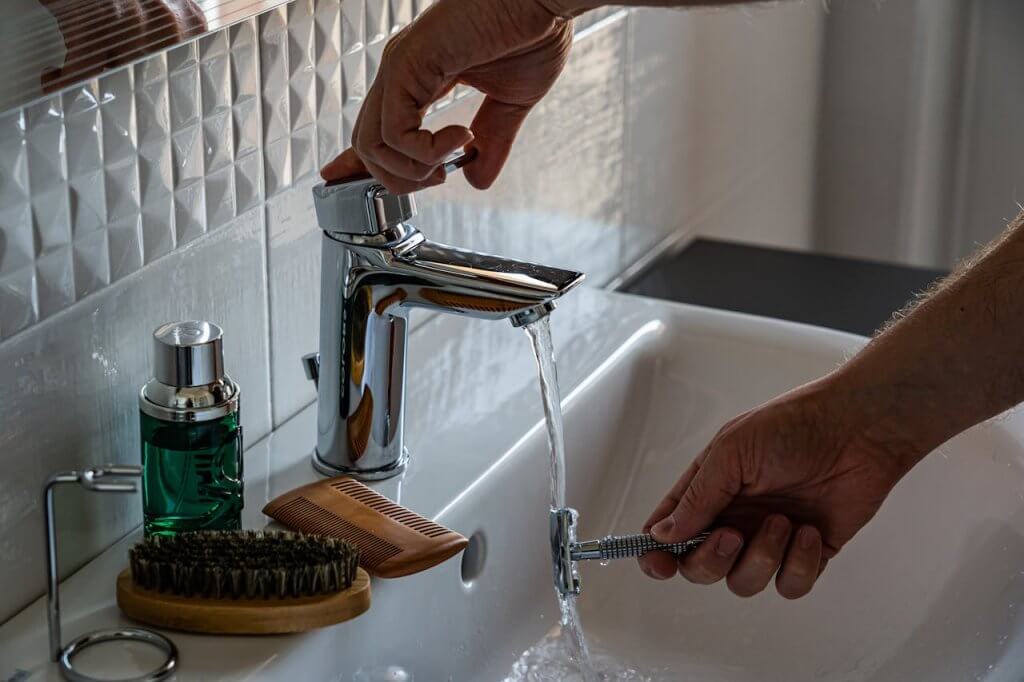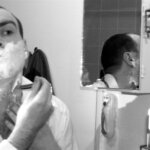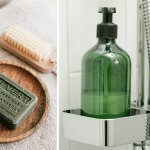
Can you get rid of “old people smell”? Explore what causes 2-nonenal and some practical steps that can make all the difference.
Back in 2017, I perceived what I thought of as an “old people smell” on a close friend.
I wondered if he’d noticed it himself. If not, a well-turned-out man like that would surely want to know. It didn’t help that his cologne only mingled with it.
But what would be the point of broaching such a delicate matter if nothing could be done about it? It would only sap his confidence.
This led me to do some research.
Googling “old people smell,” I found little on the internet advising on how to get rid of it. But there was plenty on the science behind it—I learned that the correct term was 2-nonenal.
Eventually, I came across a soap via Amazon containing persimmon extract, a tannin-rich Japanese product that claimed to control 2-nonenal. I ordered and waited several weeks for it to arrive.
In spite of breaking it to him with great tact, my friend was mortified when he learned of his odor—but grateful I’d told him. I handed him the soap, and it worked.
Since then, we’ve been exploring other ways of overcoming 2-nonenal. And over time, a lot more information has come to light on the internet.
What Causes 2-Nonenal?
As it turns out, the Japanese have been ahead of the game for quite a while. In fact, it was researchers from Japan who discovered 2-nonenal in 2001.
Without bogging you down with the science, here’s a simple explanation of its causes. I’ve provided links in case you want to dig deeper.
2-nonenal is a volatile aldehyde compound that is formed through the oxidation of fatty acids found in sebum. It’s often compared to rusting but, due to its organic nature, I think of it more in terms of “gone off.” To my nose, it smells like a mix of stale oil and buckwheat.
It’s more distinctive in men than women, with production beginning at about 40. But it’s not usually noticeable until after 60—my friend was 67 at the time. That’s because men produce more sebum, its output increasing with age. More sebum means more fatty acids available to oxidize, which in turn means more 2-nonenal.
Poor diet, hormonal shifts, and stress can trigger its presence in younger individuals, so it’s not strictly a symptom of aging.
Noticing Your Own 2-Nonenal
Like my friend, many people don’t notice their own “old people smell.”
And to make things worse, men living alone may have nobody to tell them. Therefore, regardless of how cloying and off-putting it is for others, they will never know.

How to Overcome 2-Nonenal
But don’t think it has anything to do with hygiene.
2-nonenal is non-bacterial and water-resistant. That’s why normal showering, laundering, and housecleaning won’t get rid of it.
To remove it from the body, you’ll need tannins. These bind to the offending fatty acids to help wash them away.
For household surfaces, soft furnishings, and clothing, there is nothing on the market to deal with 2-nonenal specifically. But you can neutralize it with vinegar, baking soda, and/or activated charcoal.
2-nonenal basically clings to everything you come into contact with—even the air around you. As previously mentioned, it’s a volatile compound. This means that in spite of it being a liquid, its molecules behave like a gas at room temperature, evaporating into the air and contributing to odor.
Getting Rid of “Old People Smell” on the Body
Because 2-nonenal is a result of oxidation, antioxidants are the logical antidote. In this case, tannins.
Persimmon and Tea Extract
Search for “2-nonenal” or “old people smell” on Amazon.com, and you’ll find soaps, body washes, and body wipes containing persimmon extract, whose tannins effectively get rid of the offending fatty acids.
And to slow the production of 2-nonenal, persimmon is often blended with oolong or green tea.
Another lifesaver is a persimmon deodorant by Mirai Clinical. This you can apply to all high-sebum areas, which are the scalp, the neck, behind the ears, the chest, and the back.
A DIY Body Spray to Rid You of “Old People Smell”
If you’ve just discovered the presence of 2-nonenal, you won’t have any of the above products at hand. And it could take time for them to arrive once you’ve ordered.
I’ve therefore devised a tried and tested body spray that may help in the meantime.
Ingredients:
- 1 oolong or green tea bag
- 240 mL of hot water (80°C or 176°F to preserve the tea’s chemical profile)
- 1 tbsp white vinegar (its smell dissipates within a few minutes)
- Spray bottle (preferably glass or BPA-free plastic)
Instructions:
- Steep the tea in the hot water for 10-15 minutes.
- Let it cool completely.
- Add the vinegar.
- Pour into the spray bottle and shake gently.
Mist the solution on all affected body areas, and lock in with moisturizer. Avoid anything heavily fragranced since it could interfere with the spray’s odor-neutralizing action.
Best are products like La Roche-Posay’s Toleriane Double Repair with niacinamide, glycerin, and ceramides. This is fragrance-free and suitable for all skin types, including sensitive.
Or for dry skin, The Ordinary’s Natural Moisturizing Factors + HA is a good choice. It’s budget-friendly, deeply hydrating, and fragrance-free.
Showering and Bathing
2-nonenal clings to dead cells. This is why it’s important to exfoliate about once a week with a body scrub.
In case you don’t have one at hand, my go-to is a mix of baking soda and body wash, which I also use on my scalp.
For the more delicate throat area, apply a chemical exfoliant. Try The Ordinary’s AHA and BHA Peeling Solution.
Between scrubs and chemical exfoliation, apply soap or body wash with a washcloth, which works as a gentle exfoliating tool that won’t irritate the skin, even if used daily. It’s also more hygienic than loofahs and similar items since it can be laundered after each use.
Hair
Instead of shampoo, wash your hair and scalp with a persimmon body wash.
If you don’t yet have one, apply the above DIY spray as a prewash treatment, leaving it to work for 10-15 minutes before shampooing.
Depending on how you wear your hair, you could also spray it on after washing to minimize further 2-nonenal production.
Consider shaving your head for enhanced odor control; this removes a major surface where 2-nonenal can accumulate. The same goes for beards that extend to the throat.
Hat and Cap Wearers
With or without hair, 2-nonenal will collect in your headgear.
Always apply either the above DIY spray before wearing or Mirai Clinical’s all-over deodorant.
The hat itself should be neutralized after use with a one-part white vinegar and three-part water solution. A light misting suffices.
Wigs and Toupees
Wig and toupee wearers should proceed in exactly the same way as with other headwear; deodorize your scalp before putting it on, and mist the hairpiece lightly with a vinegar solution after use.
If you wear a long-term bonded hair replacement system with a silicone base, reconsider its viability and ask your stylist for alternatives that support better odor control.
Wear Breathable Fabrics
Breathable fabrics like cotton, linen, and bamboo help keep the skin cool and dry, reducing the triggers that lead to excess sebum and odor.
Moisture-wicking cotton-polyester blends, commonly used in dress shirts, offer breathability and dryness. They help transport sweat away from the skin while maintaining airflow, making them ideal for daily wear.
Neutralize 2-Nonenal from the Inside
To further reduce 2-nonenal production, pay attention to what you eat and drink.
- Hydrate: Drinking plenty of water helps flush toxins and keeps skin healthy.
- Green or Oolong Tea: 2–5 cups daily provide tannins that combat oxidation.
- Antioxidant-Rich Foods: Eat more broccoli, squash, sweet potatoes, and mushrooms. Shiitake and oyster mushrooms contain higher levels of compounds that help prevent fatty acid oxidation while supporting the body’s natural cell-cleaning process.
- Omega-3: Found in fish, algae, and flaxseed, this helps balance fatty acid profiles. Try capsules or eat more fatty fish like salmon and sardines.
- Avoid: Smoking, alcohol, and processed fats ramp up oxidative stress and accelerate aging from within.
How to Rid Clothing of “Old People Smell”
To my knowledge, there’s no laundry detergent on the market that specifically targets 2-nonenal.
Instead, use 150–240 mL of white vinegar in place of fabric softener during the rinse cycle.
You can also add 1 tablespoon of baking soda to the main wash to help neutralize lingering odors and soften the water.
These two ingredients work together: vinegar breaks down the aldehyde compounds, while baking soda lifts embedded oils and deodorizes the fabric.
Focus especially on collars, pillowcases, undershirts, and headwear and anything else that comes into contact with sebum-rich areas.
For deeply embedded odors, try soaking garments in a one-part water and three-part vinegar solution for 30 minutes before washing. The same solution is effective when misted on previously worn but unlaundered garments.
The above-given vinegar-water dilutions are safe for most fabrics.

Household Cleaning and Deodorizing
This is not only interesting if you have 2-nonenal yourself, but also if you’ve moved into a house that was previously occupied by a sufferer. Even if all furnishings and carpeting have been removed, it can still linger.
Redecorating may do the trick, but if you’re not quite ready for that, here are some other fixes.
Vinegar Solution
Again, your best friend is a one-part water, three-part white vinegar solution.
Mist it over all fabrics and soft furnishings, from curtains and upholstery to cushions and rugs. Do this regularly if you are a sufferer.
Use it, too, for mattress toppers. It goes without saying that bed linen should be changed frequently.
For hard surfaces, including paintwork, glass, and mirrors, clean with pure white vinegar and a dash of dishwashing liquid in a spray bottle. But don’t use it on stone or other sensitive materials; do a patch test or seek further advice if in doubt.
Baking Soda
Baking soda works by absorbing odor. Although not as effective as white vinegar, it is ideal for carpeting, which may cover a large area.
To use, sprinkle and spread with a soft brush or broom, leave to work for one or two hours, then vacuum.
Baking soda can also be used on fabrics, upholstery, and soft furnishings. But be careful with velvet since it can diminish sheen.
Activated Charcoal
Another effective option is activated charcoal.
Place sachets in closets and drawers to neutralize lingering odor after laundering.
If you invest in an air purifier, make sure it has a charcoal filter.
HEPA filters capture particles like pollens and dust, while charcoal traps gases and volatile compounds like 2-nonenal.
Ventilation
Most importantly, ventilate your space.
Install an extractor fan if possible, and create a cross breeze, even if it’s only for a few minutes in cold weather.
2-nonenal may be stubborn, but it’s manageable. With the right tools and approach, you can feel comfortable, in control, and confident.
© 2025 J. Richardson
Related Posts
Disclaimer
The information provided by The Neat and Tidy Man (“we,” “us,” or “our”) on theneatandtidyman.com (the “site”) is for general informational purposes only. While we endeavor to keep the information up to date and correct, we make no representation or warranty of any kind, express or implied, regarding the completeness, accuracy, reliability, suitability, adequacy, validity, or availability of any information on the site. Under no circumstance shall we have any liability to you for any loss or damage of any kind incurred as a result of the use of the site or reliance on any information provided on the site. Your use of the site and your reliance on any information on the site is solely at your own risk.



